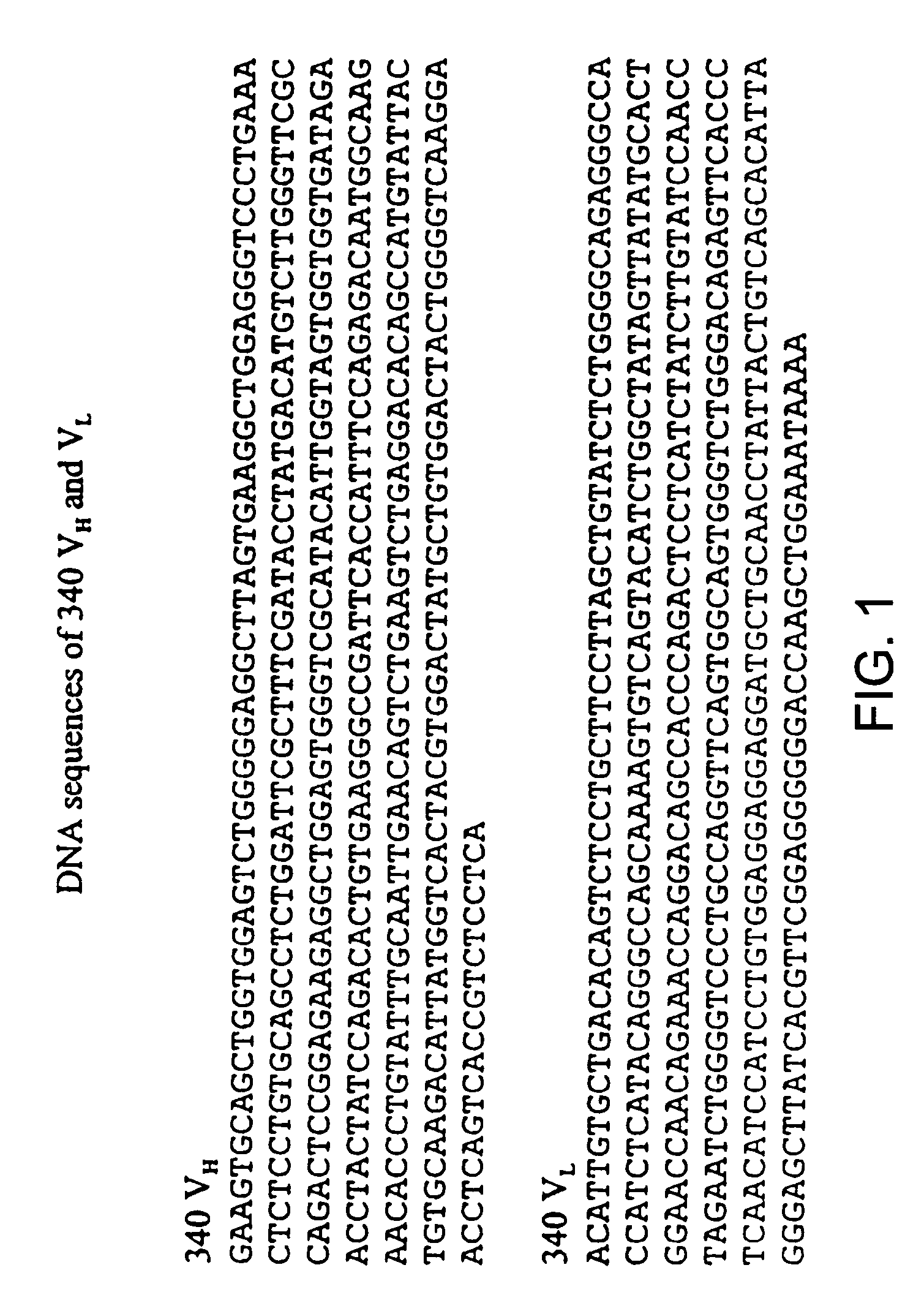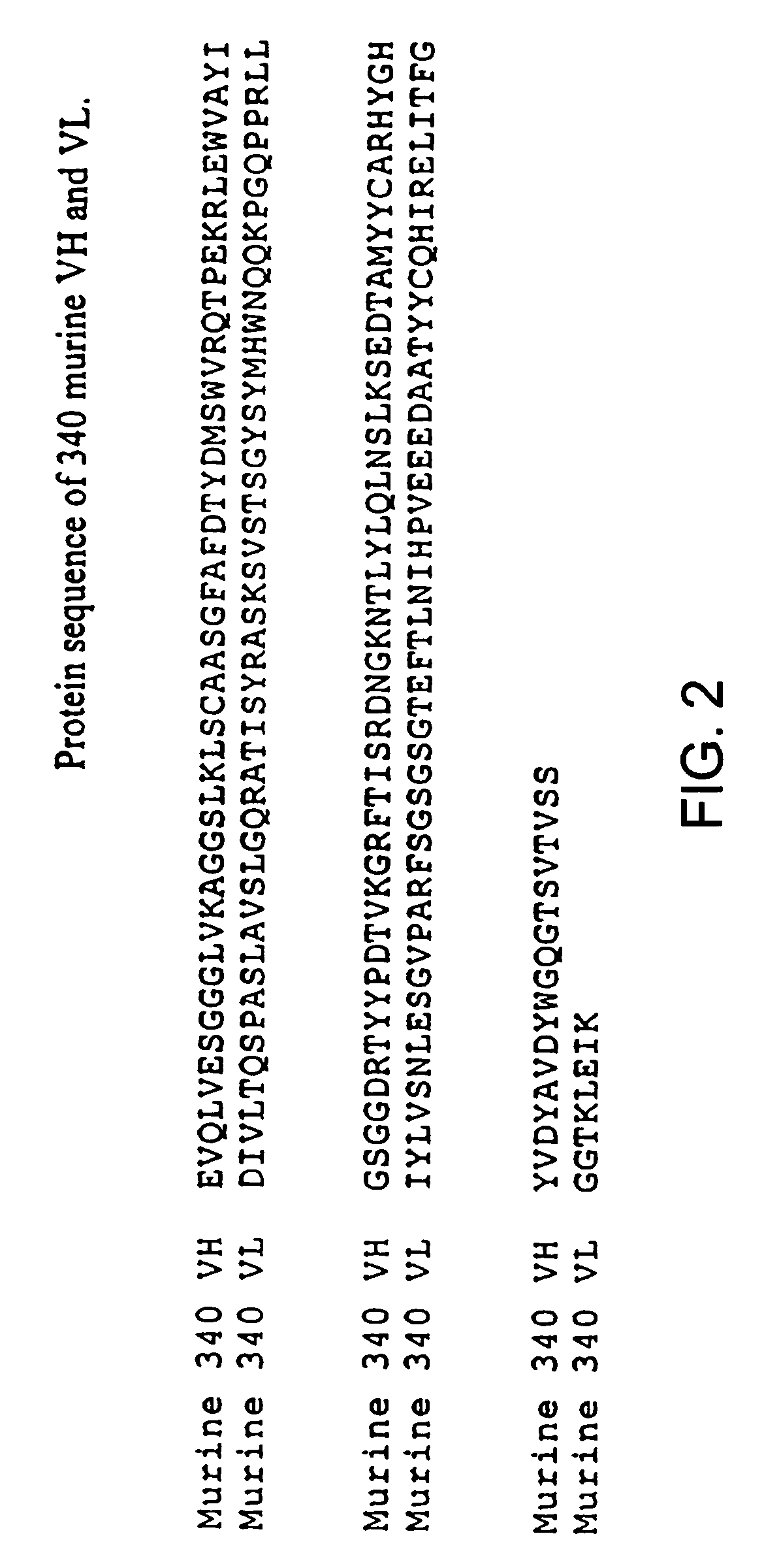De-immunized streptokinase
a streptokinase and deimmunization technology, applied in the field of substantially nonimmunogenic proteins, can solve the problems of reduced antibody effectiveness, limited use of rodent monoclonal antibodies for therapeutic and in vivo diagnostic applications in man, and no method has provided any means of avoiding or eliminating immunogenic epitopes at framework:cdr junctions
- Summary
- Abstract
- Description
- Claims
- Application Information
AI Technical Summary
Benefits of technology
Problems solved by technology
Method used
Image
Examples
example 2
[0097]In this example, a range of antibodies were tested in mice to compare immune responses. As a source of antibody to elicit an immune response in mice, the humanized VH fragment from Example 1 was deliberately altered to insert two murine MHC class II epitopes as shown in FIG. 8. This was undertaken by SOE PCR (Higuchi et al., Nucleic Acids Research, 16: 7351 (1988)) using primers as detailed in FIG. 9. Using methods as in Example 1, for the murine de-immunized version the MHC class II epitopes were removed from the altered humanized VH fragment and this was also veneered to substitute exposed residues from the murine 340 sequence. The resultant sequence is shown in FIG. 10 and the synthetic oligonucleotides used shown in FIG. 11.
[0098]The murine de-immunized VH fragment from above and the humanized and murine VH fragments from Example 1 were joined either to human or murine C region fragments of isotope IgG2. For human, a 7.2 kb HindIII-BamHI genomic fragment from IgG2 C region...
example 3
[0101]mRNA was isolated from 5×106 hybridoma 708 cells (Durrant et al., Int. J. Cancer, 50: 811 (1992) using TRIZOL™ reagent (Life Technologies, Paisley, UK) according to the manufacturers' instructions. The MRNA was converted to cDNA / mRNA hybrid using READY-TO-GO™ T-primed First Strand Kit (Pharmacia Biotech, St. Albans, UK). Variable region heavy (VH) and light (VL) chain cDNAs were amplified using the primer sets using the method of Jones and Bendig (Bio / Technology, 9: 188 (1991)). PCR products were cloned into pBLUESCRIPT II SK (Stratagene, Cambridge, UK) or pCRTM3 (Invitrogen, The Netherlands) and six individual clones each of VH and VL were sequenced ion both directions using the Applied Biosystems automated sequencer model 373A (Applied Biosystems, Warrington, UK). Resultant VH and VL sequences are shown in FIG. 13 and the corresponding protein sequences in FIG. 14.
[0102]A de-immunized antibody was generated by analysis of the sequence of FIG. 14. To remove B-cell epitopes, t...
example 4
[0103]A set of vaccine molecules were constructed based on the 708 antibody. As before, the various VH and VL molecules were assembled from long synthetic oligonucleotides using the method of PCR recombination (Daugherty et al, ibid.). Cloning, sequencing, addition of human IgG1 and κ constant regions and expression in NS0 cells was as for the 340 antibody (Example 1).
[0104]The first antibody vaccine (“Vaccine 1”) comprised the 708 heavy and light chains from which all potential human T-cell epitopes have been removed from both antibody chains, using the method described in Example 1, including epitopes found in the CDRs, apart from the region encompassing CDRs 2 and 3 and framework 3 of the heavy chain which contains the desired human epitopes. The antibody chains were not “veneered” to remove B-cell epitopes. The resultant protein sequences are shown in FIG. 17. The oligonucleotides for assembly of 708 Vaccine 1 VH and VK are shown in FIG. 18. The primary PCR used oligonucleotides...
PUM
| Property | Measurement | Unit |
|---|---|---|
| molecular weight | aaaaa | aaaaa |
| pharmaceutical composition | aaaaa | aaaaa |
| structures | aaaaa | aaaaa |
Abstract
Description
Claims
Application Information
 Login to View More
Login to View More - R&D
- Intellectual Property
- Life Sciences
- Materials
- Tech Scout
- Unparalleled Data Quality
- Higher Quality Content
- 60% Fewer Hallucinations
Browse by: Latest US Patents, China's latest patents, Technical Efficacy Thesaurus, Application Domain, Technology Topic, Popular Technical Reports.
© 2025 PatSnap. All rights reserved.Legal|Privacy policy|Modern Slavery Act Transparency Statement|Sitemap|About US| Contact US: help@patsnap.com



